Bareroot hedges offer better value ($10-15/foot) and develop deeper root systems when planted November-March, while potted plants provide quicker establishment year-round at higher cost ($15-45/foot). Your top choices include adaptable Privet, drought-resistant Yew, wildlife-friendly Hawthorn, year-round Cherry Laurel, and chalky-soil-loving Beech. For sandy soils, consider Honeysuckle or Lavender. Success rates approach 100% for both types with proper first-year watering. The perfect hedge balances your budget, timeline, and garden conditions.
The Cost Factor: Breaking Down Hedge Investment Options
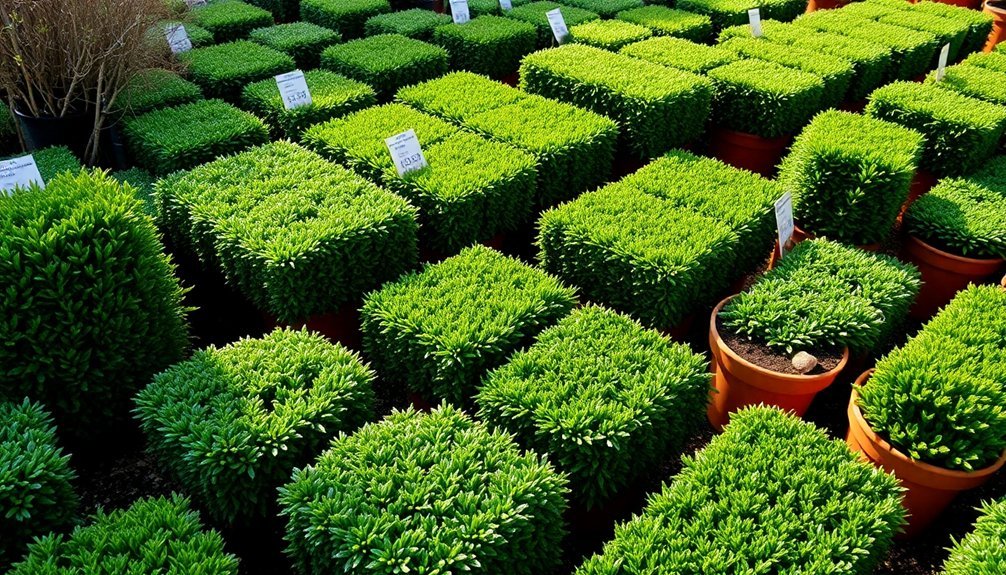
Four key elements determine your hedge investment: cost per linear foot, species selection, installation complexity, and long-term maintenance needs. Expect to spend between $10-$45 per linear foot, with taller hedges commanding premium prices of $750-$2,250 for a 50-foot stretch.
Your choice between bareroot and potted options greatly impacts your budget. Bareroot plants cost less initially but require more immediate care, while potted varieties establish faster but at a higher upfront cost. The presence of site obstacles like rocks or trees may require additional removal work, significantly increasing your overall installation expenses.
Bareroot hedges save money upfront but demand your attention, while pricier potted varieties offer convenience through faster establishment.
Consider regional variations too—labor rates and climate conditions can dramatically shift your total investment.
Don't overlook site complexity—slopes, poor soil, and accessibility challenges all increase installation costs.
Finally, factor in long-term maintenance, as fast-growing species might save money upfront but demand more frequent pruning over time.
Seasonal Planting: When to Choose Bareroot vs. Potted
Timing your hedge installation properly can dramatically impact its long-term success and establishment rate. Bareroot plants thrive when planted during their dormant period from November to March, while potted hedges offer year-round planting flexibility except during severe frost.
When making your seasonal planting decision, consider these key factors:
- Weather Windows – Bareroot plants require planting before dormancy breaks, while potted plants can be installed nearly any time, giving you flexibility around unpredictable weather patterns.
- Immediate Impact – Spring and summer projects benefit from potted plants' instant visual effect.
- Budget Timing – Plan for bareroot purchases in winter months to maximize cost savings for larger projects. The lower cost associated with bareroot options makes them particularly advantageous for extensive hedge installations.
Remember that regional climate variations will influence your best planting timeline regardless of which option you choose.
Success Rates: Comparing Establishment of Different Hedge Types
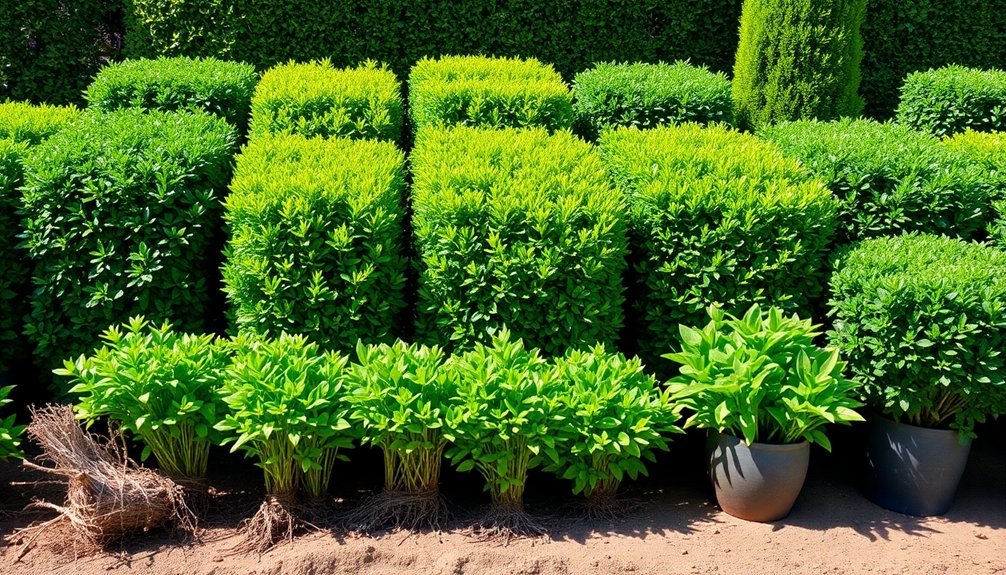
Understanding the success rates of different hedge types can greatly influence your planting decisions and long-term satisfaction.
With proper care, bare root hedges can achieve nearly 100% success despite their typical 10% failure rate. Products like Rootgrow can considerably improve their establishment. Just as financial investors use risk mitigation techniques, gardeners should hedge against plant failure by selecting appropriate varieties for their soil conditions.
Container grown plants offer minimal transplant shock, leading to quick establishment and high success rates. You'll appreciate their year-round planting flexibility.
Root ball hedges, with their established root systems, also boast excellent success rates and faster establishment.
Instant hedging provides the highest certainty as suppliers typically replace weaker plants before delivery.
Seed sown hedges, while economical, present the most unpredictable results. For reliable performance, consider the more established planting methods, especially if you're new to hedge cultivation.
Fast-Growing Privacy Screens: Best Species for Quick Results
When privacy is your priority, selecting fast-growing hedge species can transform your outdoor space in minimal time.
These varieties offer rapid results while maintaining aesthetic appeal.
- Leylandii – Growing up to 90cm annually, this evergreen creates a dense screen quickly but requires regular pruning to prevent excessive height.
- Weeping Lilly Pilly – With impressive growth of 1.5 meters per year, it's ideal for establishing privacy in shaded areas while offering a bushy appearance.
- Glauca Pencil Pine – Reaching about 1.5 meters yearly, this low-maintenance option forms a tall, evergreen barrier with minimal trimming needed.
Cherry Laurel and Privet are excellent alternatives, growing 60cm and 30-60cm per year respectively, while providing year-round coverage and formal appearances. The best time to plant these privacy hedges is during autumn to early spring, avoiding periods when the ground is frozen or waterlogged.
Wildlife-Friendly Hedging: Species That Benefit Local Ecosystems
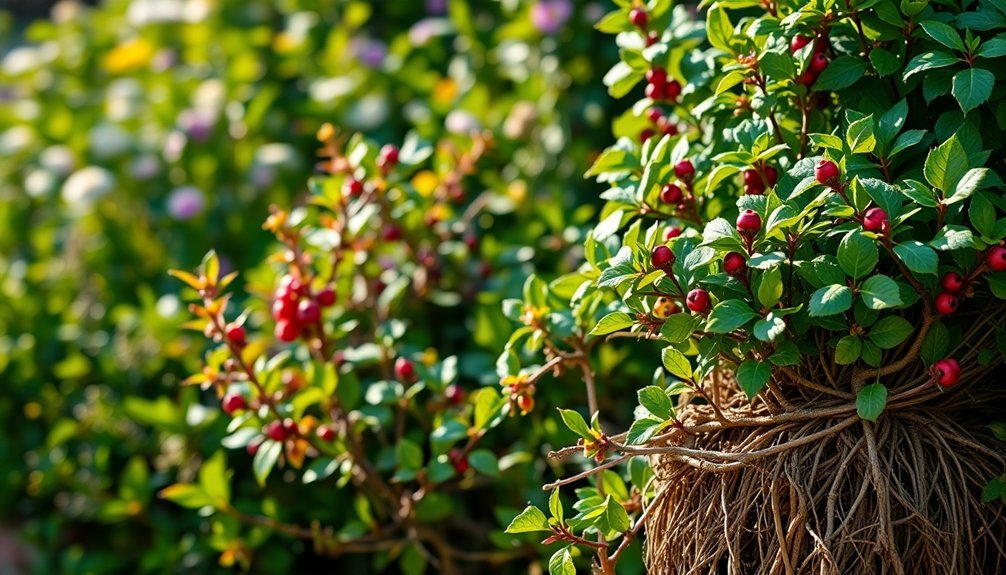
Transforming your garden into a wildlife haven starts with selecting the right hedge species. Native hedges support an impressive array of wildlife – up to 80% of woodland birds, 50% of mammals, and 30% of butterflies.
Native hedges aren't just boundaries—they're thriving ecosystems supporting countless species in your backyard sanctuary.
For maximum ecological impact, consider hawthorn and blackthorn for their dense protective cover and nutritious berries. Hazel provides energy-rich nuts while rowan attracts diverse wildlife with its flowers and berries.
Don't overlook alder, which supports valuable invertebrates like caddis flies. Common hazel adds tremendous value with catkins that pollinators actively seek out during the early spring months. For pollinators, incorporate wild rose and honeysuckle as climbing additions.
If you're concerned about hedgehogs, creating these living corridors can help combat their population decline. Species like holly offer year-round shelter, while guelder rose and sea buckthorn provide vibrant berries that birds love.
Root System Development: Long-Term Growth Considerations
Your hedge's root system needs 2-3 years to fully establish, with most growth occurring in spring and early summer.
Watering deeply but infrequently encourages roots to grow downward, ultimately improving drought resistance as the hedge matures.
You'll notice your hedge requiring less supplemental water by year three, signaling that the root system has developed sufficient depth and spread to sustain the plant during dry periods. Bare root hedges generally develop more fibrous root systems than potted alternatives, which can lead to quicker establishment and stronger long-term growth.
Initial Root Establishment
Understanding the foundation of successful hedges begins with proper root establishment. When planting bareroot hedges, you'll benefit from their larger root mass that enables better nutrient absorption from the start. These plants integrate more seamlessly with native soil since they don't have pre-existing soil barriers around their roots. The lifting methods used for bare root plants actually stimulate additional root growth, further enhancing their establishment potential.
For ideal establishment success, consider these critical factors:
- Planting timing – Install bareroot plants during dormant seasons when soil moisture is naturally higher.
- Root handling – Make sure roots remain moist but not waterlogged during the planting process.
- Initial care – While bareroot plants need thorough watering after planting, they typically require less ongoing maintenance than potted alternatives.
Though bareroot hedges may take slightly longer to show visible growth, their superior root establishment leads to more vigorous long-term performance.
Seasonal Growth Patterns
While initial root development provides the foundation for your hedge's success, the long-term seasonal growth patterns determine its ultimate vigor and resilience. Your hedge roots will continually form new growth throughout their lifetime, adapting to environmental changes.
Root growth ebbs and flows with seasons – typically accelerating during spring and early summer when soil conditions are ideal. You'll notice bareroot hedges often establish deeper, more extensive root systems than their potted counterparts. This advantage comes from bareroot plants being field grown and lifted during their dormant period, allowing for natural root development.
| Season | Root Activity | Maintenance Needs |
|---|---|---|
| Spring | Rapid growth | Deep watering |
| Summer | Moderate growth | Mulching, consistent moisture |
| Fall | Slowing, energy storage | Fertilization for winter prep |
| Winter | Minimal activity | Protect from freezing, avoid waterlogging |
To maximize long-term development, practice infrequent but deep watering to encourage downward root expansion rather than shallow surface roots that are vulnerable to drought.
Drought Resistance Development
Developing drought resistance in your hedge's root system involves three critical processes that determine long-term survival during water scarcity. Your hedges adapt by prioritizing deeper root growth while slowing above-ground development, allowing them to access water stored in deeper soil layers. Recent research shows that plant hormones like abscisic acid significantly influence how roots grow in response to drought conditions.
The foundation of drought-resistant hedges lies in:
- Root architecture optimization – Plants that develop deeper, more efficient root systems can maintain growth even when surface soil becomes dry.
- Hormonal regulation – Abscisic acid and auxin work together to direct root growth angles toward available moisture.
- Energy conservation – Drought-resistant varieties reduce redundant root growth, channeling resources to where they're most needed.
Understanding these mechanisms helps you select hedges that naturally develop root systems capable of withstanding prolonged dry periods.
Soil Adaptability: Which Hedge Types Work in Your Garden
Soil composition forms the foundation of hedge success in your garden. For chalky conditions, consider beech, box, hornbeam, thuja, or yew—all thrive without amendment and offer varied aesthetic benefits.
If you're dealing with coastal or sandy soil, options like honeysuckle, lavender, euonymus, hawthorn, and field maple will establish themselves readily while withstanding challenging conditions. Incorporating organic matter mulch can significantly improve water retention in chalky soil, which is especially beneficial during dry summer months.
Portuguese Laurel adapts to poor soils where English Laurel might show chlorosis. For fast privacy, Leyland Cypress and American Arborvitae 'Green Giant' grow several feet annually.
Your regional climate also matters—yew and boxwood suit temperate areas, while thuja thrives in colder zones.
Privet remains one of the most adaptable choices across various environments, making it a reliable standby regardless of your garden's soil profile.
Maintenance Requirements: Year One and Beyond
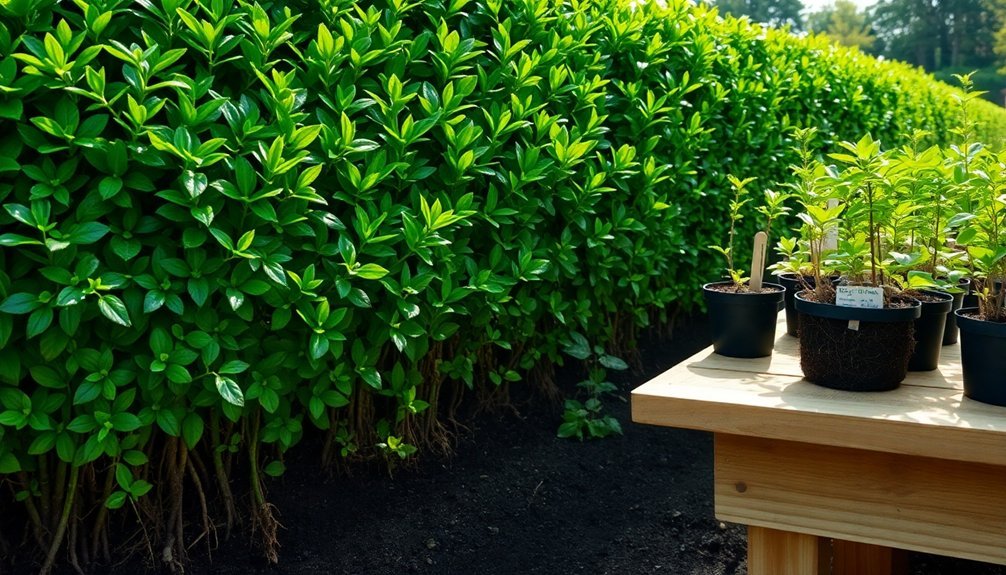
Your hedge's first year demands consistent watering but minimal pruning to establish strong roots.
As it matures, you'll need to adjust your pruning schedule based on whether you've chosen evergreens (typically once yearly) or deciduous varieties (usually twice yearly). During this first year, focus only on trimming vigorous shoots while allowing the plant to acclimate to its new environment.
Different seasons call for specific maintenance tasks, with spring fertilization, summer watering, and fall or dormant-season pruning forming the backbone of your hedge care routine.
Initial Watering Regimens
Establishing a proper watering regimen remains the most critical factor in hedge survival during the first year of growth.
Whether you've chosen bareroot or potted hedges, they'll need consistent moisture to develop strong root systems during their establishment period.
Your watering approach should adapt to three key factors:
- Soil type – Clay soils retain moisture longer, while sandy soils require more frequent watering to prevent drying out.
- Seasonal conditions – Increase watering during dry spells and reduce during dormant periods.
- Planting method – Bareroot hedges typically need daily watering in dry weather until established.
For efficient irrigation, consider installing drip hoses or porous pipes along your hedge line. Thorough watering encourages roots to grow deeper, creating long-term establishment that will benefit your hedge for years to come.
These deliver water directly to the roots while conserving water and reducing evaporation—particularly beneficial during summer months.
Pruning Different Hedge Types
Proper pruning forms the backbone of successful hedge maintenance, with different varieties requiring specific approaches throughout their lifecycle.
During the first year, minimize pruning to allow establishment, removing only vigorous shoots that disrupt balance. When establishing new hedges, consider selecting varieties that require minimal pruning frequency for long-term low maintenance.
For common varieties, pruning frequency varies considerably. Emerald Green Arborvitae needs attention only every 2-3 years, while fast-growing Green Giants require twice-yearly trimming.
Boxwoods and privets fall somewhere between, needing one to two annual prunings.
Timing matters too—deciduous hedges benefit from summer pruning, while evergreens prefer late summer. For flowering varieties, wait until blooms fade.
Always cut at angles to allow sunlight penetration, keeping the top slightly narrower than the base.
Remember to avoid pruning during bird nesting season to protect wildlife habitats.
Seasonal Care Differences
While establishing a beautiful hedge requires careful planting, success ultimately depends on understanding the distinct seasonal care needs throughout its development. Bareroot and potted hedges have different maintenance schedules you'll need to follow for ideal growth.
1. First Year Focus – Bareroot hedges demand consistent moisture during establishment without overwatering, while potted varieties need more frequent watering as they tend to dry out faster.
Apply mulch to both types to retain moisture. Regular maintenance helps prevent bare patches and weak growth that can compromise the hedge's appearance and health.
2. Fertilization Timing – Feed bareroot plants in early spring after establishing; potted hedges may already contain starter nutrients but require additional feeding during active growth periods.
3. Long-Term Development – Bareroot hedges typically develop more substantial root systems and faster growth once established, while potted hedges might grow slower if they become rootbound.
Evergreen vs. Deciduous: Year-Round Appearance Considerations
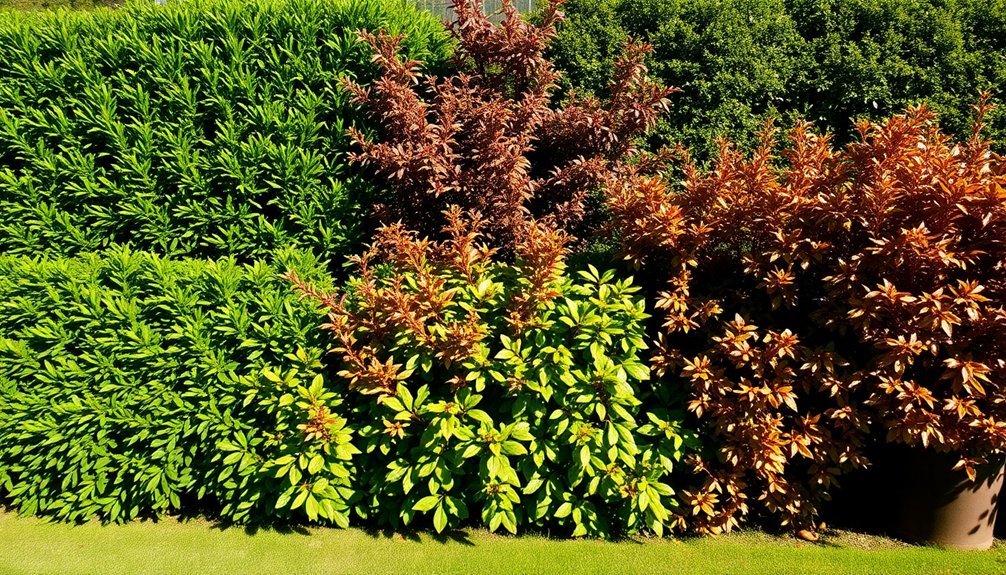
The choice between evergreen and deciduous hedges greatly impacts your garden's appearance throughout the seasons.
Evergreens offer consistent, formal structure and year-round privacy with minimal foliage loss, making them ideal if you're seeking a permanent visual barrier. Many evergreen varieties are effective noise reducers when planted densely.
Choose evergreens for reliable structure that delivers year-round privacy and creates permanent garden architecture without seasonal compromise.
Deciduous options like Beech and Hawthorn provide dramatic seasonal changes, shifting from lush summer greens to striking autumn colors. While they shed leaves in winter, varieties like Beech retain dried foliage, maintaining structural interest even during dormancy.
Your selection should align with your aesthetic preferences and practical needs. If you prioritize year-round screening, consider Yew or Cherry Laurel. For wildlife attraction and seasonal variety, Hawthorn excels.
Remember that evergreens typically require less seasonal cleanup but might provide a more static visual experience.
Mixing Hedge Species: Creating Biodiversity in Your Living Fence
Beyond the evergreen versus deciduous debate lies an opportunity to embrace ecological richness through mixed-species hedges. When you combine different plant varieties in your hedgerow, you're creating a thriving ecosystem that benefits wildlife, soil health, and the environment.
Mixed hedges offer three significant advantages:
- Enhanced wildlife habitat – Different species support various birds, insects, and small mammals throughout the year.
- Extended seasonal interest – Varied flowering times, berries, and foliage changes provide continuous visual appeal.
- Improved resilience – Diverse plantings reduce disease vulnerability and adapt better to changing climate conditions.
Your living fence becomes not just a boundary marker but an ecological powerhouse, filtering pollutants, preventing soil erosion, and creating microhabitats for beneficial organisms—all while requiring less maintenance than monoculture alternatives.
Frequently Asked Questions
Can I Plant Bareroot Hedges in Containers Temporarily?
Yes, you can plant bareroot hedges in containers temporarily. Use well-draining soil, maintain consistent moisture, and consider this only a short-term solution before permanent planting in the ground for best results.
How Far Apart Should Different Hedge Species Be Planted?
Spacing varies by species: plant evergreens like Leylandii at 60-100cm, formal hedges at 30-60cm, and deciduous species at 30-90cm apart. You'll need closer spacing (20-40cm) for dense hedges like boxwood.
Do Hedges Require Special Fertilizers After the First Year?
After the first year, you don't need special fertilizers for hedges. Apply a balanced NPK fertilizer in spring and sometimes in fall. Established hedges benefit from regular compost or well-rotted manure applications.
Can I Trim My New Hedge in the First Planting Season?
You generally shouldn't trim most new hedges in their first planting season. Only quickthorn, blackthorn, bare root privet or laurel need initial pruning. Let other varieties establish their roots before pruning after the first year.
How Do Hedges Affect Property Boundaries and Neighbor Relations?
Hedges serve as natural property boundaries but can spark disputes if unclear. You'll benefit from discussing maintenance with neighbors and understanding the hedge and ditch rule when determining exact boundary lines.
In Summary
Whether you've chosen bareroot or potted hedging, your new living boundary will transform your garden's look and function. You'll find the best success by matching your hedge choice to your specific conditions and needs. Remember, establishment takes time—but with proper care in the first year, your hedge will reward you with privacy, wildlife habitat, and seasonal interest for decades to come.





Leave a Reply